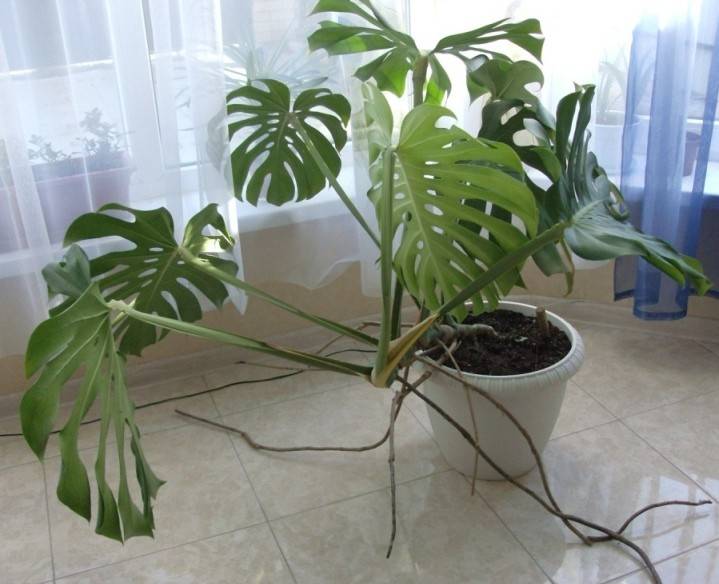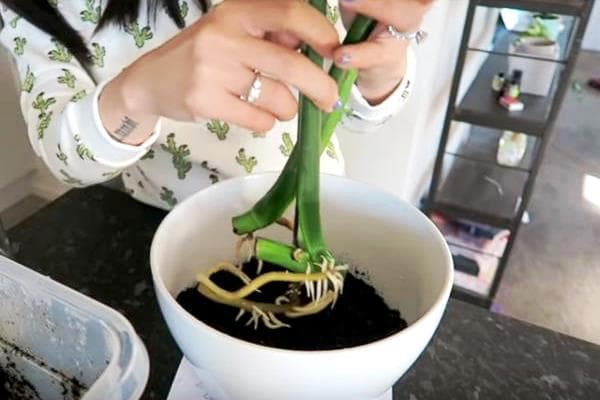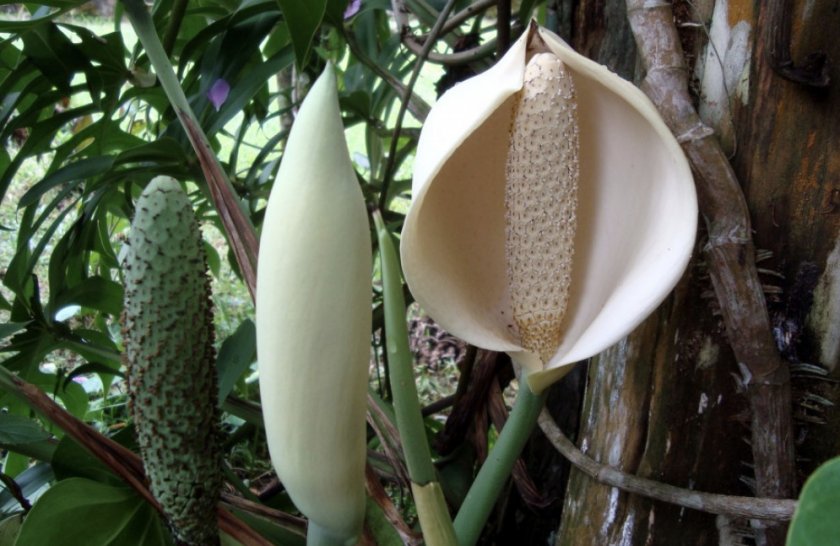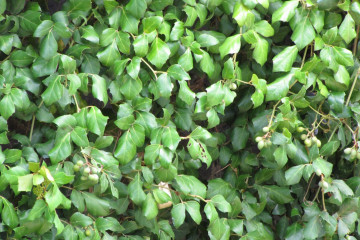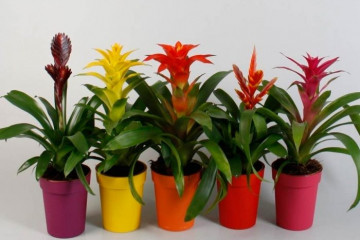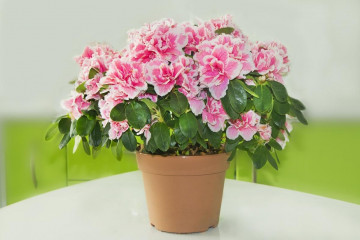Monstera - home care, transplant and reproduction
Content:
The monster was brought to Russia from the tropics. There, in the usual conditions of a mild climate with increased dampness, the flower existed quietly without much care. In his homeland he was called "the elegant monster" because of its frightening beauty. Although the monstera is adapted to the living conditions of the apartment, it blooms very rarely, because the home climate is very different from the tropical one. And creating high humidity in the room is a rather difficult task.
The leaves of this unusual flower reach up to 35 cm in diameter, sometimes even more. And it can be high to the ceiling. Gardeners call the plant “crybaby” because large droplets of liquid can be seen forming on the greenery. This phenomenon happens before the rain, so the plant is said to predict the weather. This article tells you how to properly care for a monster yourself and what mistakes should not be made.
Monstera: home care
Everything is extremely simple and straightforward.
Optimal location and lighting
How to take care of a monster in apartments? Due to the fact that the flower is actively growing and takes up a lot of space, it can often be seen in large office spaces. Growing a plant in regular apartments is also encouraged. They put it in bedrooms or living rooms, provided there is good lighting and high humidity.
Caring for a monstera flower at home is quite simple. It is necessary to observe a certain lighting regime. You cannot put the plant near windows or on window sills overlooking the northern part of the house, there is too little light there, so the growth of the vines will slow down. If the flower is located in the southern part of the room, you need to make sure that open sun rays do not fall on it. In bright, diffused light, the flower will grow vigorously, so the best location is a window facing east or west.
Requirements for soil and capacity for planting
For the correct development of the monstera, you need to pay attention to the ground. Mostly it is purchased in stores, but you can do it yourself.
The soil for a plant should contain the following components:
- sod land;
- peat;
- humus;
- leafy land;
- river sand.
These components must be mixed in a ratio of 3: 1: 1: 1: 1. Such soil will absorb moisture well and allow air to pass through. When choosing dishes for planting monstera, you need to take into account the maximum growth of the future plant. In a large container, it will quickly strengthen its roots and begin to grow immediately, but as soon as the monstera reaches large dimensions, the roots will curl and wrap themselves in a circle. To prevent the plant from strangling itself, at the time of its transplant, you need to untangle and cut off the excess roots, otherwise the flower may dry out.
It is better to take a container more than it was, by 5 cm in diameter. It is important that it is stable.
Optimum air humidity
Monstera leaves need constant spraying, wiping and polishing. If in winter the plant stands near heating appliances, then wipe it more often so that the tips of the foliage do not dry out.
Watering and feeding
First you need to know about the characteristics of the water used for irrigation. It is recommended that it be filtered. Temporary use of well-settled water is allowed. In winter, the land should only be slightly damp.
In other periods of the year, the monster needs to be watered abundantly, the earth should have time to dry out. In summer, you need to add water to the pallet, but so that it does not stagnate for a long time.
Continuous wiping of the leaves with a damp cloth is recommended, and a spray bottle can be used to humidify the air. Wiping and spraying should be done with warm clean water.
Fertilization and feeding play a very important role in the life of a monstera. The best option for a positive result is feeding, which will be carried out once every 22 days. Thanks to this, the roots will receive and consume many useful elements.
It is advisable to apply fertilizer in early March. It is then that the growth of the monstera is activated.
Aerial roots and monstera formation
To begin with, it is advisable to find air roots. An inexperienced grower may mistake fresh stems for them. Aerial roots are formed on the stems depending on the growth of the flower. They mainly grow next to the leaves, have a woody structure. They will be light brown in color. Often these roots even grow around the pot.
What to do with aerial roots
To change position, there are several options for how to deal with the air roots:
- you can neatly tie them to common stems as they form, so that they slowly grow to the soil and can take root on their own;
- place three more containers with soil near the pot with the plant and put the roots in them. Then, after rooting, you get several shoots of the vine;
- you can arrange containers with liquid so that rooting takes place in it. But it is worth remembering that the water needs to be changed regularly;
- roots can be wrapped in wet moss. This option adds external beauty and makes it possible to start rooting;
- there are special wooden sticks trimmed with dry palm threads. A large vine can be attached to such a stick by making a small hole in it to secure the air roots. Often such holes are covered with soil or simply constantly sprayed from a sprayer;
- the aerial roots of the monstera can be simply cut off, but not completely. The flower will not deteriorate if you shorten the roots a little and give it a neat look. Of course, you do not need to cut off absolutely everything, in which case the plant may get sick or even dry out. Sometimes the leaves may just turn yellow.
Possible problems
Florists often note the following changes:
- flower leaves are not large, not cut, on long stems. If this is the case for the whole flower, it is due to a lack of light. It is necessary to move the pot to a more lighted place;
- the leaves of the monstera turned yellow. With massive yellowing, too much soil moisture can be a problem, especially in the winter season. Also, in an apartment from high dampness, the leaves can become very soft. With a lack of minerals, they turn yellow evenly from the tip. In this case, you need to check the soil and loosen it if possible;
- dry brown plaques form when moisture is poor or when the apartment is too dry. You need to water the soil more often;
- if there are brown plaques along the entire edge of the leaf, then this is a lack of minerals. It happens in old flowers that have not been transplanted for a long time;
- petals are pale pink, become dark, then turn brown. This happens when there is a lot of sunlight, especially the disease manifests itself in the spring;
- bald lower part of the stem, small leaves, poorly cut, long internodes. The reason is a strong lack of light;
- yellowness or drying of the flower can also be caused by insects. You need to inspect the plant with a magnifying glass from all sides.
Pests, diseases and treatments
The following insects and ailments can hit the monster:
- Fusarium is a fungal infection in the soil that loves high humidity. When damaged, the roots of the plant rot, the stem becomes thin, the leaves are yellow. There is no cure, the monstera dies;
- late blight is a fungus due to which the roots and trunk rot. Infection occurs mainly through liquid, soil and equipment. Symptoms of the disease are brownish-purple plaques with a pale green circle, as well as white plaque on the leaves. There is no way to cure;
- chlorosis - yellowing of the leaves, which become evenly transparent, which also happens when the plant is exposed to the sun for a long time. For treatment, you need an iron chelate in the dose indicated in the instructions (you can buy the product in flower shops);
- the ivy scale is located everywhere, the plant becomes depressed, it looks ugly, the leaves are yellow, a sooty mushroom is formed. To fight, the petals and stems are washed with soapy water, the air temperature is lowered and the humidity is increased. A 0.2% rogor solution is used, and severely affected parts are removed;
- a spider mite lives from below the petals and weaves a web on them, drinks monstera juice, from which it withers and dries up. During treatment, the apartment is constantly ventilated, the air humidity is increased, and the plant is treated with actellic.
How to propagate with apical and stem cuttings
The stalk is cut, of course, from the crown of the flower. To facilitate the process, it is simply placed in water. After a few weeks, the cutting will take root.
This method requires a good cut of the stem. The stem cutting should have two buds. To root it, you need a container of a suitable size with light peat soil, on which the cutting is simply placed bud side down. You do not need to fill it up.
Next, the stalk is placed under a transparent glass or film cover, sometimes sprayed, moistened, and ventilated. With the appearance of roots, the first leaf also grows. After rooting, the flower can be planted in a permanent place.
Transplant and rejuvenation
For five years, the monster needs to be replanted every year. This is done mainly in the middle of spring. Older flowers are transplanted less often - 1 time in 3 years.
Step-by-step instructions for transplanting a monstera:
- The pot must be chosen 2-3 cm larger than the old one. It is not recommended to take too large a container, since water will stagnate in the ground where there are no roots, which can cause death.
- A drainage layer of about 5 cm is poured onto the bottom of the pot (for example, broken brick).
- The land can be bought ready-made, specialized, or made with your own hands from peat, river sand, humus and turf.
- The roots will not suffer much if the plant is transplanted by transshipment. To do this, it is abundantly moistened in an old pot, and a day later it is carefully pulled out along with the soil and placed in a new one.
- The empty place is covered with fresh earth. In the first week, the flower should not be watered.
- If the lower part of the monstera begins to lose leaves, it needs rejuvenation. To do this, in the spring, you need to cut off about 25 cm of the crown. This will stimulate the growth of the lateral stems and make the plant more beautiful.
Caring for a monster at home is available even to a novice gardener. You need to adhere to the basic rules when watering and positioning the flower. It is important not to forget that the plant needs to be bathed. During certain periods, carry out various feeding and fertilizing. Monstera variegated needs constant crown pruning and removal of old leaves. It is not very difficult to grow it. It is important to take proper care of this exotic plant. When buying in a store, you must definitely check with the seller how to care for the monster, since different varieties require different care.


